Hebdomas pocket watches have a high recognition value due to their appearance – the off-centered hands and the balance visible on the dial side with a large balance bridge immediately catch the eye. Here we take a look at the techniques of the movements of these watches.
Hebdomas in Greek and Latin refers to the Holy Week. These watches promise to run for at least a week without being rewound. Even a little more, since the dial usually says 8 Jours, 8 Days or 8 Tage.

The story in a nutshell
The inventor of the Hebdomas is considered to be Irénée Aubry from Saignelégier in Switzerland, who received Swiss patent number CH88 for a first version of these watches in January 1889. Translated into English, it bears the somewhat unwieldy title “New Arrangement of the Mechanism for Watches of All Sizes, Especially Applicable to Jewelry Watches and Watches That Go for Eight Days and More.”


A few months later, Aubry transferred the patent to the company Aubry, Graizely & Godat, which then began to produce the Hebdomas pocket watches. Graizely further developed Aubry’s concept by patenting the familiar shape of the large balance bridge in Swiss patent CH24675 in 1901.
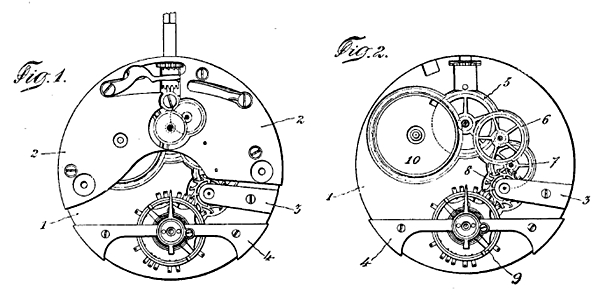
The name Hebdomas was established for this version with the large balance bridge, but only around 1906.
Aubry retired from the business in 1912 and in 1913 Otto Schild took over Graizly & Co. He produced about 1,000 Hebdomas watches per day with Schild & Co in La Chaux-de-Fonds around 1918! So the watches were obviously very successful, which can be judged by the fact that these watches were produced until the 1970s. By the way, Otto Schild had nothing to do with the famous movement manufacturer Adolph Schild S.A. (AS, ASSA)!
After the termination of Schild & Co, the rights to the design and brand Hebdomas passed in 1982 to the company Xantia, which produced these watches until the 1990s. So, with a total production time of almost 100 years, the Hebdomas watches can rightly be called a successful model!
Anyone interested in a comprehensive review of the history of Hebdomas watches will find what they are looking for in this very readable article by Stephen Foskett: Hebdomas: The True Story of the 8-Day Pocket Watch – Grail Watch (grail-watch.com)
The technology of Hebdomas watches
The visibility of the balance on the dial side and the large balance bridge already indicate an unusual construction of the movement. But also the back of the movement has a special feature to offer. It is completely covered by a very large mainspring barrel, which is also typical for Hebdomas watches.
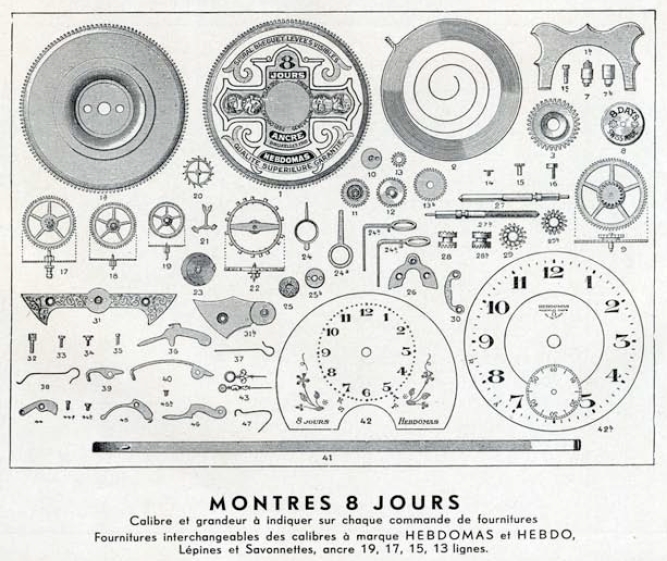
This is how the movement looks when dismantled:

And after removing the dial:

On the dial side, there is the inscription HEBDOMAS and the caliber number 101 in a shield, the logo of Schild & Co. The large screw with the two holes in the center of the mainspring barrel can be removed with an old special tool, the cover plate lifter.

An old grinded tweezers, ideally made of copper, so that it does not leave scratches when turning, will work as well.
An old grinded tweezers, ideally made of copper, so that it does not leave scratches when turning, will work as well.
But be careful! The screw has a left-hand thread, so it must be turned to the right to open. Unfortunately, this is often overlooked, and the screw is damaged accordingly. Used Hebdomas watches therefore often look like on the next picture. The original screws are replaced more or less intelligently, but the thread is almost always screwed up.

This is what it looks like underneath the barrel and on its rear side:
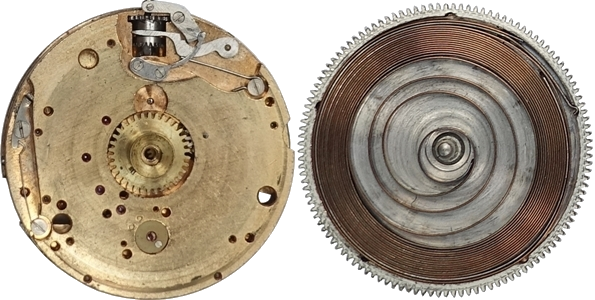
The large wheel in the center of the movement is not the hour wheel, as is usually the case with clock movements, but the barrel arbor, which drives the gear train on the other side of the movement via its teeth. In a classic movement, the gear teeth of the mainspring barrel take over this role. On the next picture, you can see the function of the mainspring barrel core a bit better.
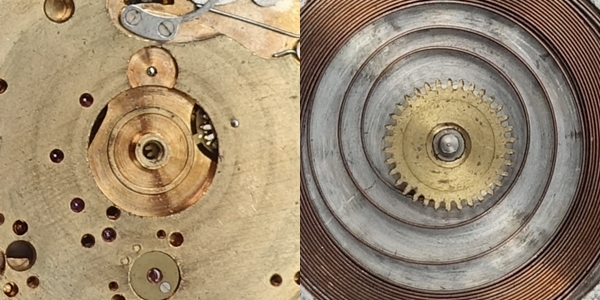
The teeth on the outer edge of the barrel are used for winding and for engaging the click. Here, the barrel is rotated during winding and the barrel arbor rotates during unwinding. In a classic movement design, it’s the other way around. The barrel has an inner diameter of 36 mm and the spring has a length of 120 cm! The long running time must come from somewhere.
But the barrel has even more to offer! It contains a drag spring to which the mainspring is riveted. In the next picture, the green arrow marks the beginning of the drag spring, the red arrow its end. The mainspring runs along the outer edge of the drag spring and is riveted to it at the point marked with the red oval. The bent end of the mainspring engages in one of 5 notches in the edge of the mainspring barrel (blue rectangles), as long as the mainspring presses strongly and precisely against it. If the mainspring pulls the hook to the center when winding the movement, the mainspring will eventually leave the notch and jump loudly to the next one. The spring therefore has no fixed stop when the movement is fully wound.

The loud cracking of the bent end of the drag spring is often interpreted as a defective mainspring! On the following video, this cracking can be heard well from second 11.
By the way, there is also a variant where the mainspring is not riveted to the drag spring, but is hooked into a catch on the drag spring. The next picture shows such a specimen:

Let’s take another look at the gear train:
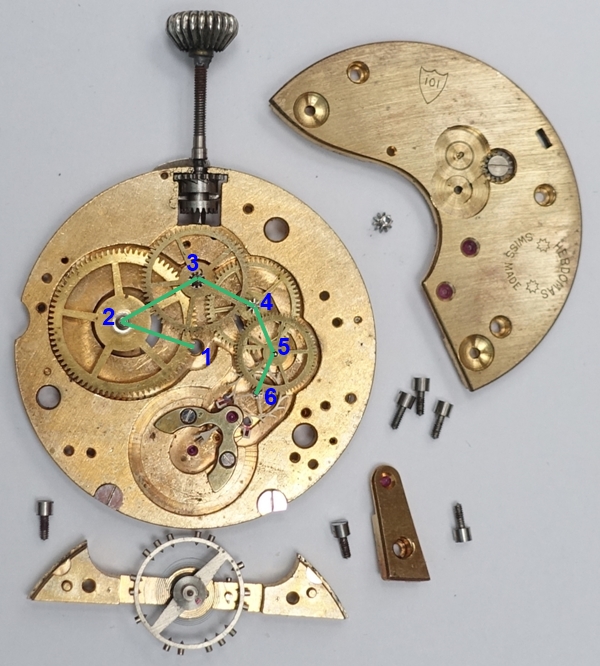
The geen line shows the force flow from the barrel arbor (1) via the intermediate wheel (2), the large driving wheel (3), the third wheel (4) and the fourth wheel (5) to the escape wheel (6).
The large driving wheel, also called center wheel, is located in the center of the movement in a classic movement design. Since the time display on Hebdomas movements is decentralized, the large driving wheel must naturally also be decentralized here.
The intermetiary wheel is typical for 8-day movements, also in clocks. It provides the appropriate transmission between the mainspring barrel and the rest of the gear train. In these Hebdomas watches, the mainspring barrel rotates only about 1.4 times per day.
Finally, here are the technical data of the movement shown:
- Dimensions: 18 3/4´´´ (French lines), height 9.1 mm
- Swiss lever escapement
- Hour, minute, without second hand
- 15 jewels
- Monometallic screw balance with flat hairspring
- Beat rate: 18,000 bph
- No shock protection
- Crown winding

I have been considering a Hebdomas ‘Daynite’ 8 Day watch, but am not sure the winding required is a great proposition. 8 days power reserve is approximately 6 times that of a typical 35 hour watch but the real problem is that crown mainspring barrel diameter is conderably greater than a normal watch. Therefore, The Hebdomas requires approximately 20 winds of the crown for one turn of the barrel compared to 3 and 4 for a normal watch, that is 5x more. Multiply 5 x 6 (for the 8 days vs 35 hours reserve) and it takes over 30x times the number of crown turns to fully wind. My typical watch winding requires around 20 turns to fully wind, so the Hebdomas will require approximately 600 turns! My Eberhard 8 Jours is designed rather differently and does not have this problem. Pity, good sounding concept but the reality is putting me off.
I justed checked that. It took 140 half-turns of the crown to fully wind it. Half turns because that’s what you usually do with your fingers. And it took about one minute. That’s not a big deal.
Thanks for writing this interesting post. I recently found what I think is a hebdomas 8 day pocket watch whilst metal detecting on an old town coastal tip site. The images via the link, show the condition of the watch when I dug it out of the mud, I have been slowley cleaning it over the last week and it’s coming up quite nicely. The embossed pattern on the case looks like an oriental floral pattern, but I can’t find another example like it online. There is a number on the inner workings 51001 and the number 4 above this. If anyone could give me anymore information about the watch I’d be very grateful.
Stuart
Link to photos
https://photos.app.goo.gl/cugytX3jb5sze9jz9
Great info!!! Thank you!
Hi Andreas
I have a several of these movements, two of which are working and the others are a “work in process”.
On the ones I have there is no “101” stamped into the plate, is there anything else on the movement that could identify the caliber as when looking for spares I don’t want to keep buying parts that don’t fit.
Is there anywhere on line that deals with replacement hands, as one of these is my grandfathers which is missing the minute hand.
Regards
Kev Kenney
Hi Kev,
I’m not a specialist for these movements. I don’t have any further information than the one you can find in my post.
Hi Andreas
Thank you anyway. Thank you for your post its given me a great insight into these watches.
Excellent info. Thank you